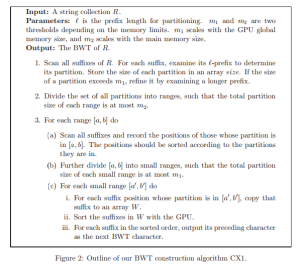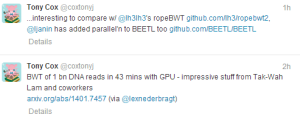
GPU-Accelerated BWT Construction for Large Collection of Short Reads
This new preprint from Chi-Man Liu, Ruibang Luo and Tak-Wah Lam is worth checking out (h/t: @lexnederbragt) !! BWT construction is a major problem for large NGS read files, and as we discussed in “What Problems are Being Solved by the Top NGS Bioinformaticians Today?”, almost every top bioinformatician has a BWT-construction project going on. There are several benefits of turning read files into BWT quickly.
(i) faster compression and easy transfer (Tony Cox’s rearranging of reads is a good example),
(ii) quick search through a large set of reads,
(iii) k-mer counting is an equivalent problem as BWT construction (see - “BWT Construction and K-mer Counting”),
(iv) genome assembly using SGA-type of algorithm.
We have not seen too many discussions of BWT construction in parallel, and therefore look forward to going through this paper in detail. Their super- duper CX1 parallel algorithm is shown in the image below (click to expand). On first impression, it seems to have similarity with Lyndon word-based constructions (here and here), because the word is broken into smaller pieces of increasing order.

Full abstract:
Advances in DNA sequencing technology have stimulated the development of algorithms and tools for processing very large collections of short strings (reads). Short-read alignment and assembly are among the most well-studied problems. Many state-of-the-art aligners, at their core, have used the Burrows-Wheeler transform (BWT) as a main-memory index of a reference genome (typical example, NCBI human genome). Recently, BWT has also found its use in string-graph assembly, for indexing the reads (i.e., raw data from DNA sequencers). In a typical data set, the volume of reads is tens of times of the sequenced genome and can be up to 100 Gigabases. Note that a reference genome is relatively stable and computing the index is not a frequent task. For reads, the index has to computed from scratch for each given input. The ability of efficient BWT construction becomes a much bigger concern than before. In this paper, we present a practical method called CX1 for constructing the BWT of very large string collections. CX1 is the first tool that can take advantage of the parallelism given by a graphics processing unit (GPU, a relative cheap device providing a thousand or more primitive cores), as well as simultaneously the parallelism from a multi-core CPU and more interestingly, from a cluster of GPU-enabled nodes. Using CX1, the BWT of a short-read collection of up to 100 Gigabases can be constructed in less than 2 hours using a machine equipped with a quad-core CPU and a GPU, or in about 43 minutes using a cluster with 4 such machines (the speedup is almost linear after excluding the first 16 minutes for loading the reads from the hard disk). The previously fastest tool BRC is measured to take 12 hours to process 100 Gigabases on one machine; it is non-trivial how BRC can be parallelized to take advantage a cluster of machines, let alone GPUs.
-———————————————————————-
Relevant twitter comments -

Nick is referring to BarraCUDA project, but iirc, it is a mapping project similar to SOAP3-dp and not BWT index generation.
